#abbot maurice
Explore tagged Tumblr posts
Text
I'm reading Gothic stories and their constantly like "This relationship must not happen" and I'm like, well yeah those two characters are cousins it's gross, and then they'll go "Because that character is disabled" or "because they're secretly siblings" and it just feels like we're skipping over the their parents were siblings part guys.
#Gothic Literature#I'm looking at you the Abbot's Ghost: Or Maurice Treherne's temptation + The Dead Smile.#Listen I understand that morality was different in the past but the the difference between half-siblings and cousins is not significant.
1 note
·
View note
Text



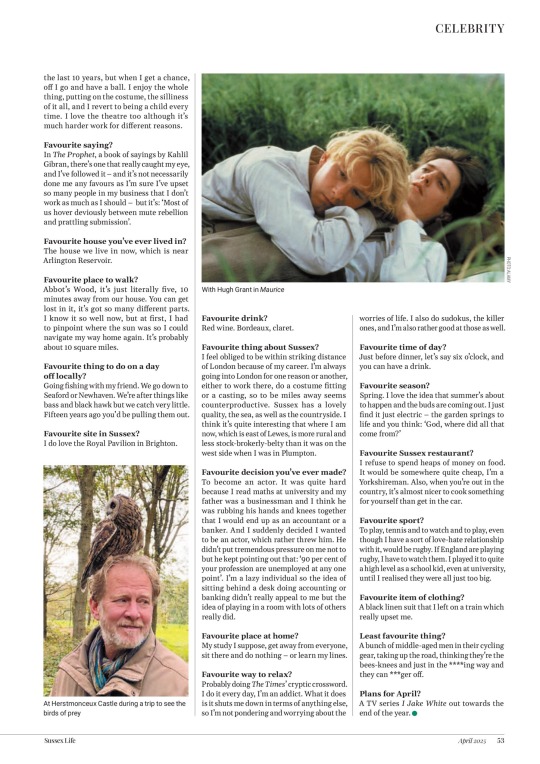
Arlington Reservoir-based actor James Wilby – My Favourite Things
By Louise Flind
Favourite role?
Maurice, because very, very rarely is a piece of theatre or film about the character you're playing, and I was in every scene bar one. And it was a harmonious experience with the director James Ivory at the helm. He was just so supportive, inventive and wonderful. And I got on very well with my two co-stars Hugh Grant and Rupert Graves, and that also doesn't always happen.
Favourite playwright?
On one level, I love Stoppard but then I find you could say some people would argue he has a slightly particular frothy style in his use of language, and on another level I’d say Shakespeare because it's so profound.
Favourite director?
James Ivory, because he's one of those directors who has an amazing eye, and also an amazing ear.
Favourite co-star?
I loved working with Jonathan Pryce in Regeneration. What's interesting about really wonderful actors is you've just got to up your game. Also, Anthony Hopkins on Howards End, and Helen McCrory, who's sadly died now, on Witness Against Hitler.
Favourite theatre?
For the structure of the building, Glyndebourne. It seems to be a celebration of theatre, I'd love to do a play there, to direct a play, but I suppose it's not allowed. And the speed at which you can get out of it and into it and the bars and the restaurants, and the grounds – everything about it is a delightful experience before you've even watched whatever you're going to watch. The sight lines are so good, you can be quite far back and you still get an amazing experience and that's very rare in theatres.
Favourite location where you’ve filmed?
Canaima in Venezuela - you had to take a little prop airplane, land on a dirt runway, and there was just a sort of club, and it had about 20 chalets and a central dining space. It looked as though it was on a lake. And to the right of the lake were these massive waterfalls. It was just amazing and we were filming A Handful of Dust there for a week, and we all had to share one of these chalets because there wasn't enough of them for the entire crew. I shared with one of the actors who got very ill and went to bed at six in the evening. So I took my script on a boat, a long canoe, and under the starlight I was easily able to read and learn my lines for the next day. Charles Sturridge directed it for ITV, but it was a feature film with Kristin Scott Thomas, Rupert Graves and Alec Guinness.
Favourite thing about yourself?
Oh, bloody hell. That's just vanity. I'm a survivor.
Favourite thing about your work/career?
I love acting. It's a lucky thing because I've actually had not such a great career over the last 10 years, but when I get a chance, off I go and have a ball. I enjoy the whole thing, putting on the costume, the silliness of it all, and I revert to being a child every time. I love the theatre too although it’s much harder work for different reasons.
Favourite saying?
In The Prophet, a book of sayings by Kahlil Gibran, there’s one that really caught my eye, and I've followed it – and it's not necessarily done me any favours as I'm sure I’ve upset so many people in my business that I don’t work as much as I should – but it’s:‘most of us hover deviously between mute rebellion and prattling submission’.
Favourite house you've ever lived in?
The house we live in now near Arlington Reservoir.
Favourite place to walk?
Abbot’s Wood, it’s just literally five, 10 minutes away from our house. You can get lost in it, it's got so many different parts. I know it so well now, but at first, I had to pinpoint where the sun was so I could navigate my way home again. It's probably about 10 square miles.
Favourite thing to do on a day off locally?
Going fishing with my friend. We go down to Seaford or Newhaven. We're after things like bass and black hawk but we catch very little. Fifteen years ago you'd be pulling them out.
Favourite site in Sussex?
I do love the Pavilion [in Brighton].
Favourite drink?
Red wine. Bordeaux, claret.
Favourite thing about Sussex?
I feel obliged to be within striking distance of London because of my career. I'm always going into London for one reason or another, either to work there, do a costume fitting or a casting, so to be miles away seems counterproductive. Sussex has a lovely quality, the sea, as well as the countryside. I think it's quite interesting that where I am now, which is east of Lewes, is more rural and less stock-brokerly-belty than it was on the west side when I was in Plumpton.
Favourite decision you've ever made?
To become an actor. It was quite hard because I read maths at university and my father was a businessman and I think he was rubbing his hands and knees together that I would end up as an accountant or a banker. And I suddenly decided I wanted to be an actor, which rather threw him. He didn't put tremendous pressure on me not to but he kept pointing out that 90% of your profession are unemployed at any one point. I'm a lazy individual so the idea of sitting behind a desk doing accounting or banking didn't really appeal to me but the idea of playing in a room with lots of others really did.
Favourite place at home?
My study I suppose, get away from everyone, and sit there and do nothing, or learn my lines.
Favourite way to relax?
Probably doing The Times’ cryptic crossword. I do it every day, I'm an addict. What it does is it shuts me down in terms of anything else, so I'm not pondering and worrying about the worries of life. I also do Sudokus, the killer ones, and I’m also rather good at those as well.
Favourite time of day?
Just before dinner, let's say six o'clock, and you can have a drink.
Favourite season?
Spring. I love the idea that summer's about to happen and the buds are coming out. I just find it just electric – the garden springs to life and you think, God, where did all that come from?
Favourite Sussex restaurant?
I refuse to spend heaps of money on food. It would be somewhere quite cheap, I'm a Yorkshireman. Also, when you're out in the country, it's almost nicer to cook something for yourself than get in the car.
Favourite sport?
To play, tennis and to watch and to play, even though I have a sort of love-hate relationship with it, would be rugby. If England are playing rugby, I have to watch them. I played it to quite a high level as a school kid, even at university, until I realised they were all just too big.
Favourite item of clothing?
A black linen suit that I left on a train which really upset me.
Least favourite thing?
A bunch of middle-aged men in their cycling gear, taking up the road, thinking they're the bees-knees and just in the ****ing way and they can ***ger off.
Plans for April?
TV series ‘I, Jack Wright’ out towards the end of the year.
April, Sussex Life Magazine
34 notes
·
View notes
Text

NEW: My Favourite Things - Great British Life magazine Interview April 2025
Favourite role?
Maurice because very, very rarely is a piece of theatre or film about the character you're playing, and I was in every scene bar one. And it was a harmonious experience with the director James Ivory at the helm. He was just so supportive, inventive and wonderful. And I got on very well with my two co-stars Hugh Grant and Rupert Graves, and that also doesn't always happen.
Favourite playwright?
On one level, I love Stoppard but then I find you could say some people would argue he has a slightly particular frothy style in his use of language, and on another level I’d say Shakespeare because it's so profound.
Favourite director?
James Ivory, because he's one of those directors who has an amazing eye, and also an amazing ear.
Favourite co-star?
I loved working with Jonathan Pryce in Regeneration. What's interesting about really wonderful actors is you've just got to up your game. Also, Anthony Hopkins on Howards End, and Helen McCrory, who's sadly died now, on Witness Against Hitler.
Favourite theatre?
For the structure of the building, Glyndebourne. It seems to be a celebration of theatre, I'd love to do a play there, to direct a play, but I suppose it's not allowed. And the speed at which you can get out of it and into it and the bars and the restaurants, and the grounds – everything about it is a delightful experience before you've even watched whatever you're going to watch. The sight lines are so good, you can be quite far back and you still get an amazing experience and that's very rare in theatres.
Favourite location where you’ve filmed?
Canaima in Venezuela - you had to take a little prop airplane, land on a dirt runway, and there was just a sort of club, and it had about 20 chalets and a central dining space. It looked as though it was on a lake. And to the right of the lake were these massive waterfalls. It was just amazing and we were filming A Handful of Dust there for a week, and we all had to share one of these chalets because there wasn't enough of them for the entire crew. I shared with one of the actors who got very ill and went to bed at six in the evening. So I took my script on a boat, a long canoe, and under the starlight I was easily able to read and learn my lines for the next day. Charles Sturridge directed it for ITV, but it was a feature film with Kristin Scott Thomas, Rupert Graves and Alec Guinness.
Favourite thing about yourself?
Oh, bloody hell. That's just vanity. I'm a survivor.
Favourite thing about your work/career?
I love acting. It's a lucky thing because I've actually had not such a great career over the last 10 years, but when I get a chance, off I go and have a ball. I enjoy the whole thing, putting on the costume, the silliness of it all, and I revert to being a child every time. I love the theatre too although it’s much harder work for different reasons.
Favourite saying?

In The Prophet, a book of sayings by Kahlil Gibran, there’s one that really caught my eye, and I've followed it – and it's not necessarily done me any favours as I'm sure I’ve upset so many people in my business that I don’t work as much as I should – but it’s:‘most of us hover deviously between mute rebellion and prattling submission’.
Favourite house you've ever lived in?
The house we live in now near Arlington Reservoir.
Favourite place to walk?
Abbot’s Wood, it’s just literally five, 10 minutes away from our house. You can get lost in it, it's got so many different parts. I know it so well now, but at first, I had to pinpoint where the sun was so I could navigate my way home again. It's probably about 10 square miles.
Favourite thing to do on a day off locally?
Going fishing with my friend. We go down to Seaford or Newhaven. We're after things like bass and black hawk but we catch very little. Fifteen years ago you'd be pulling them out.
Favourite site in Sussex?
I do love the Pavilion [in Brighton].
Favourite drink?
Red wine. Bordeaux, claret.
Favourite thing about Sussex?
I feel obliged to be within striking distance of London because of my career. I'm always going into London for one reason or another, either to work there, do a costume fitting or a casting, so to be miles away seems counterproductive. Sussex has a lovely quality, the sea, as well as the countryside. I think it's quite interesting that where I am now, which is east of Lewes, is more rural and less stock-brokerly-belty than it was on the west side when I was in Plumpton.
Favourite decision you've ever made?
To become an actor. It was quite hard because I read maths at university and my father was a businessman and I think he was rubbing his hands and knees together that I would end up as an accountant or a banker. And I suddenly decided I wanted to be an actor, which rather threw him. He didn't put tremendous pressure on me not to but he kept pointing out that 90% of your profession are unemployed at any one point. I'm a lazy individual so the idea of sitting behind a desk doing accounting or banking didn't really appeal to me but the idea of playing in a room with lots of others really did.
Favourite place at home?
My study I suppose, get away from everyone, and sit there and do nothing, or learn my lines.
Favourite way to relax?
Probably doing The Times’ cryptic crossword. I do it every day, I'm an addict. What it does is it shuts me down in terms of anything else, so I'm not pondering and worrying about the worries of life. I also do Sudokus, the killer ones, and I’m also rather good at those as well.
Favourite time of day?
Just before dinner, let's say six o'clock, and you can have a drink.
Favourite season?
Spring. I love the idea that summer's about to happen and the buds are coming out. I just find it just electric – the garden springs to life and you think, God, where did all that come from?
Favourite Sussex restaurant?
I refuse to spend heaps of money on food. It would be somewhere quite cheap, I'm a Yorkshireman. Also, when you're out in the country, it's almost nicer to cook something for yourself than get in the car.
Favourite sport?
To play, tennis and to watch and to play, even though I have a sort of love-hate relationship with it, would be rugby. If England are playing rugby, I have to watch them. I played it to quite a high level as a school kid, even at university, until I realised they were all just too big.
Favourite item of clothing?
A black linen suit that I left on a train which really upset me.
Least favourite thing?
A bunch of middle-aged men in their cycling gear, taking up the road, thinking they're the bees-knees and just in the ****ing way and they can ***ger off.
Plans for April?
TV series ‘I Jake White’ out towards the end of the year. source: https://www.greatbritishlife.co.uk/magazines/sussex/24967090.arlington-reservoir-based-actor-james-wilby---favourite-things/
#james wilby#james wilby actor#poldark#maurice#a summer story#a handful of dust#immaculate conception#maurice hall#I Jack Wright#By Royal Appointment
32 notes
·
View notes
Text
“Errors, shortcomings and omissions in the area of canonical procedural norms have been identified, which the bishops deeply regret,” said the Swiss Bishops’ Conference, summarising the response of the dicastery, a kind of arbitration body in the Vatican. There had been no misconduct that would require the opening of criminal proceedings within the Church today.
In June 2023, the Dicastery for Bishops commissioned the Bishop of Chur, Joseph Maria Bonnemain, to conduct a preliminary canonical investigation to look into various allegations against several Swiss bishops. According to the Swiss Bishops’ Conference, the results were forwarded to the Dicastery for Bishops in Rome at the beginning of this year, to which the Vatican has now responded.
Accusation of sexual abuse
Bonnemain’s mission from the Vatican was to investigate the conduct of four members of the Swiss Bishops’ Conference for possible failure to report assaults. A fifth member of the Bishops’ Conference was to be investigated for alleged sexual harassment.
Nicolas Betticher, former vicar general of the diocese of Lausanne, Geneva and Fribourg, had reported several Swiss bishops within the church for covering up. The abbot of Saint-Maurice in Valais, Jean Scarcella, accused of sexual abuse and cover-up, subsequently resigned from office in September 2023 in order to, as he said, “guarantee the independence of the investigation”.
Also in September last year, the University of Zurich published a study on the extent of sexual abuse in the Roman Catholic Church since the mid-20th century. This study showed that priests and members of religious orders in Switzerland had committed over 1,000 cases of sexual abuse since 1950, although the number of unreported cases is likely to be high.
9 notes
·
View notes
Note
Re: the teens ask. Ohh that sounds so fun!! Cree and Steve working in the same school is kinda like the mockumentary sitcom Abbot Elementary. Steve has the most insane dad lore I bet. Is Maurice also a teacher in school? I do see him being the type or maybe a social worker. Love how Chad, given all he’s been through, goes the opposite direction and works in a place that doesn’t deal with kids shenanigans anymore. He’s putting space with that but there’s still a part of him that isn’t immune to kid shenanigans either
I should really watch Abbot Elementary at some point. I keep hearing about it in my circles haha.
Steve dad lore IS insane, but can probably just be summed up with this:

And Maurice is a social worker, as I always felt that was the vibe for him. The renovated Adult Branch has done well in trying to work their way into those systems, and Maurice’s work is a big part of that.
Chad always said he’s done with the kid stuff and is good at enforcing boundaries. But there is a reason he keeps the temp tattoos on standby. Plus he can never say no to Maurice if the former needs a hand with something.
6 notes
·
View notes
Text
Dolores Costello - The Goddess of the Silent Screen

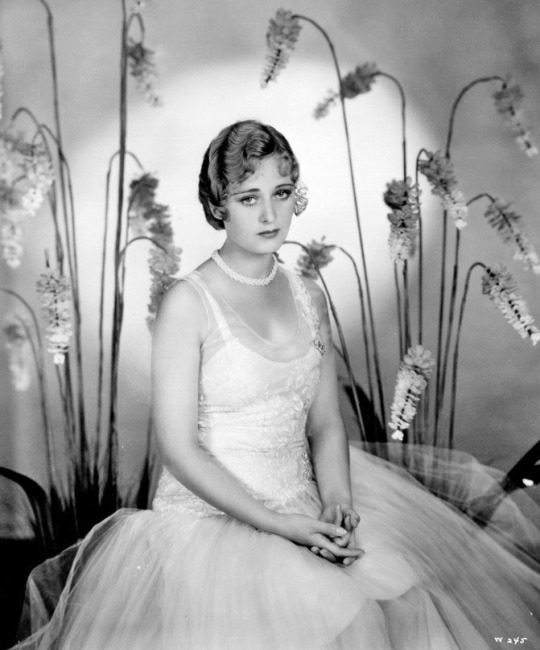

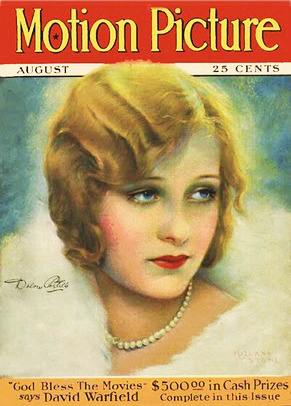
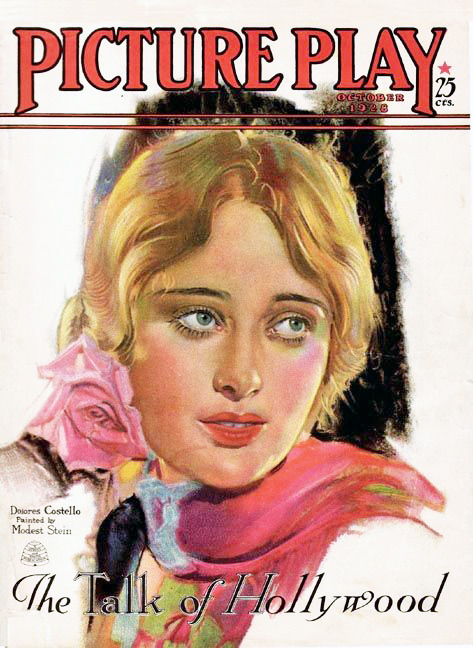

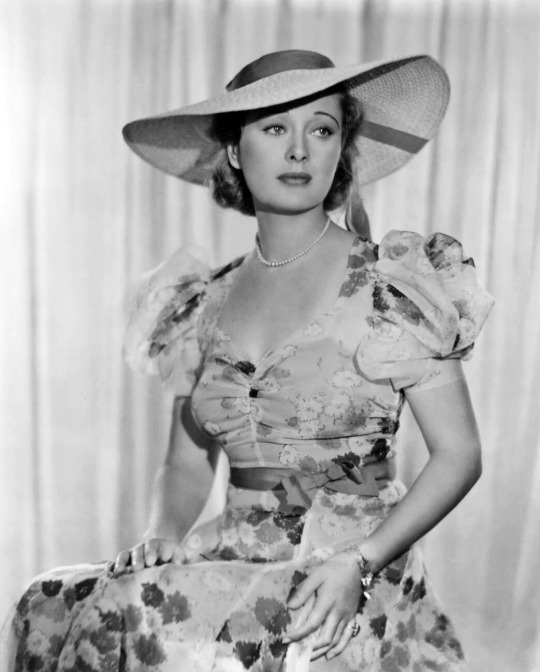





Dolores Costello (born in Pittsburgh, Pennsylvania on September 17, 1903) was an American film actress who achieved her greatest success during the era of silent movies. Her silent film career developed to the degree that she had acquired the title, “The Goddess of the Silver Screen," for her delicate beauty.
The actress was the daughter of actors Mae Costello and Maurice Costello a leading matinee idol and early screen star. She had a younger sister, Helene, and the two made their early film appearances as child actresses for the Vitagraph Film Company. They then appeared on Broadway, which resulted in contracts with Warner Bros. Pictures in 1924.
In 1926, following small parts in feature films, Costello was handpicked to star with him in The Sea Beast, a loose adaptation of Herman Melville's Moby-Dick.
Her acting career became less a priority following the birth of her first child in 1930. She resumed her career in 1936, a year after her divorce and achieved some successes, most notably in The Magnificent Ambersons (1942). She retired permanently in 1943.
She died from emphysema in Fallbrook Hospital. She was 73 years old and had been living at her avocado farm in Fallbrook, California.
Legacy:
Named as one of the WAMPAS Baby Stars in 1926
Won the Photoplay Awards - Best Performances of the Month in March 1926
Is the paternal grandmother of famous Hollywood actress, Drew Barrymore
Is the namesake of one half of America's most popular comedy duo, Abbot and Costello
Has a star on the Hollywood Walk of Fame at 1645 Vine Street for motion picture

#Dolores Costello#Dolores Barrymore#The Goddess of the Silent Screen#John Barrymore#Drew Barrymore#Silent Films#Silent Era#Silent Film Stars#Golden Age of Hollywood#Film Classics#Old Hollywood#Vintage Hollywood#Hollywood#Movie Star#Hollywood Walk of Fame#Walk of Fame#Movie Legends#movie stars#1900s#28 Hollywood Legends Born in the 1900s
6 notes
·
View notes
Text
Artist Research-Gothic Movement Secondary Research
Further on Gothic art and architecture grew in Renaissance period, paintings and architecture were one of the first forms of art. Renaissance artist such as Giotto Di Bondone and Cimabue.
During the Renaissance period a transition from the Romanesque to the Gothic style of painting happened slowly in Italy. After the conquest of Constantinople in 1204 during the Fourth Crusade, influx of Byzantine paintings and mosaics increased greatly. This was partly the reason that Italy was strongly influenced by Byzantine art, especially in painting. The initial changes to the Byzantine-inspired Romanesque style was quite small, marked merely by an increase in Gothic ornamental detailing rather than a dramatic difference in the style of figures and compositions. Italian Gothic painting began to flourish around the second half of the 13th century with the contributions of Cimabue of Florence and Giotto Di Bondone.
Cimabue: Known at the time for Gothic works including ‘St John’. Cimabue was trained in the Byzantine style and was the first great Italian painters to break away from the Italo-Byzantine. Cimabue went on to paint in an emotive Gothic style. At the time Gothic style included using curves and linear perspective. Cimabue fellow student followed this art style, this student was Giotto.
Giotto Di Bondone: Giotto was an Italian painter of the Late Gothic period whose works are seen as an important prelude to the Renaissance. Unlike other artists of his time, Giotto produced accurate paintings and drawings from observation rather than Byzantine stylization. Giotto’s style represented a clear break with the Byzantine tradition, making use of foreshortening, chiaroscuro techniques, and depicting highly expressive figures. Some of Giotto's Gothic works include ‘The Arena Chapel’ and ‘Madonna and Child’.
Architecture-Cathedrals: The Czech Church of Bones: The Gothic church standing in Sedlec near the quaint Czech Republic city of Kutná Hora. Inside in the basement to bones of thousands of humans were bleached then ornately carved, and now artfully cover the inside of the church.
The origin of this Gothic Church begins with a local abbot who made a pilgrimage in the 13th century to Jerusalem and brought back some sacred soil to spread across the church cemetery. Word got out, making the Sedlec cemetery one of the region’s most popular places to be buried.
When the plague ravaged Europe in the 14th century, nearly 30,000 victims were added to the plots. The Crusades then brought 10,000 more casualties to rest in this cemetery.
When the community started to construct the Gothic church in the 15th century, many bones were moved and stacked in pyramids in the ossuary beneath the new building. Everything was left undisturbed until 1870, when the church hired a local woodcarver, Francis Rint, to create something from the staggering piles of bones.
After bleaching and carving the bones, he used them to decorate the holy space. Rint made chains of skulls to stretch across entryways. Chalices and crosses were constructed from hips and femurs. There's even a detailed family crest, thanking the aristocratic family that funded the initiative.
Notre Dame de Paris: The cathedral was initiated by Maurice de Sully, bishop of Paris, who came up with the idea of converting into a single building, on a larger scale, the ruins of the two earlier basilicas in 1160. The foundation stone was laid by Pope Alexander III in 1163, and the high altar was consecrated in 1189. The choir, the western facade, and the nave were completed by 1250, and porches, chapels, and other embellishments were added over the next 100 years.
Notre-Dame Cathedral consists of a choir and apse, a short transept, and a nave flanked by double aisles and square chapels. Its central spire was added during restoration in the 19th century, replacing the original, which had been completely removed in the 18th century because of instability. The interior of the cathedral is 130 by 48 meters in plan, and the roof is 35 meters high. Two massive early Gothic towers (1210–50) crown the western facade, which is divided into three stories and has its doors adorned with fine early Gothic carvings and surmounted by a row of figures of Old Testanment kings. The two towers are 68 meters high. At the cathedral’s east end, the apse has large clerestory windows added in 1235 and is supported by single arch flying buttress of the more daring Rayonnant Gothic style, especially notable for their boldness and grace. The cathedral’s three great rose windows alone retain their 13th-century glass. Notre-Dame Cathedral went through great damage throughout the centuries. After the French Revolution, it was rescued from possible destruction by Napoleon, who crowned himself emperor of the French in the cathedral in 1804. Notre-Dame underwent major restorations, adding Gargoyles by French architect Eugène-Emmanuel Viollet-le-Duc in the mid-19th century.
1 note
·
View note
Text
In 2023 I have read 68 books. Here they are:
Carpe Jugulum by Terry Pratchett
The Devil and Dark Water by Stuart Turton
Orphans of the tide by Struan Murray
Ironside by Holly Black
Don Quixote by Miguel Cervantes
The Amazing Maurice and his educated rodents by Terry Pratchett
Tin Princess by Philip Pullman
The Three Musketeers by Alexander Dumas
Moby Dick By Herman Melville
Moonblood by Alastair MacNeill
Crime and Punishment by Fyodor Dostoevsky
Frankenstein by Mary Shelley
Jane Eyre by Charlotte Bronte
The Watchmaker of Filigree Street by Natasha Pulley
Little Women by Louisa May Alcott
The Seven Dials by Agatha Christie
Heart of Darkness by Joseph Conrad
The Italian Girl by Iris Murdoch
Pride and Prejudice by Jane Austin
Thus Spoke Zarathustra by Fredrich Nietszche
The woman in white by Wilkie Collins
The Wreck of the Titan by Morgan Robertson
Destination Unkown by Agatha Christie
East of Eden by John Steinbeck
The Listerdale Mystery by Agatha Christie
The Pickwick Papers by Charles Dickens
The Hunchback of Notre Dame by Victor Hugo
Poirot's Early Cases by Agatha Christie
The City of God by Augustine
Longarm and the Wendigo by Tabor Evans
Anne of Green Gables by Lucy Maud Montgomery
The Ghost Drum by Susan Price
The Last Hero by Terry Pratchett
Man's search for Meaning by Victor Frankl
When the Lion Feeds by Wilbur Smith
Journey to the West by Wu Cheng'e
Flatland by E. A. Abbot
The Island of Doctor Moreau by HG Wells
The Piano Teacher by J.Y.K. Lee
The Scarlet Letter by Nathaniel Hawthorne
Goblin Fruit by D.M. Chan
Heidi by Johanna Spyri
The Three-Body Problem by Cixian Liu
The Man who was Thursday by G.K.Chesterton
Didache
Peter Pan by J.M. Barrie
Dune:Messiah by Frank Herbert
Tarzan of the Apes by E.R. Burroughs
Eric by Terry Pratchett
1913 by Florian Illies
The Grapes of Wrath by John Steinbeck
Men at Arms by Terry Pratchett
Hour of the Wolf by A.J. Gallows
Catch 22 by Joseph Heller
Little House on the Prairie by L.l. Wilder
The Railway Children by E. Nesbit
The Hitchhikers Guide to the Galaxy: A Trilogy in five parts by Douglas Adams
From the Earth to the Moon by Jules Verne
Round the Moon by Jules Verne
American gods by Niel Gaiman
Vanity Fair by W.M. Thackery
The Master of the World by Jules Verne
The Vicar of Wakefield by Oliver Goldsmith
A Season in Hell by Jack Higgins
The Screwtape Letters by C.S. Lewis
The Price By A. Sokoloff
The Hogfather by Terry Pratchett
The Bible as your GPS by K. Genis
1 note
·
View note
Text
Today in Church History
Maurice Abbot was a clothier in a village 20 miles from London. One night his pregnant wife, Alice, dreamed that if she could catch a pike, her child would be a boy. She rushed to the nearby river and trapped a young pike in her pitcher. She cooked it, ate it, and on October 29, 1562, bore a son. The story spread through the superstitious town, and many people offered to finance the boy’s…

View On WordPress
0 notes
Text
The exact date of Conan IV’s donation isn’t known. The duke died in 1171, the presence of Bishop Geoffrey, who ascended the episcopate in 1167, makes it possible to propose that the act studied was drawn up in the years 1167-1171. These were difficult years for Conan IV. Since 1166, the year when the promise of marriage of his daughter, Constance, to the heir of Henry Il Plantegenet was sealed, he had, in a way, abdicated in favor of the King of England. He had nevertheless reserved the county of Guingamp for himself. But it is significant that he intended to continue to exercise his authority over the whole of the duchy, since this act was orchestrated in Cornouaille, a long way from the northern county, the prerogative of his house. It is true that it was a hereditary region, based on the ducal lineage from which his mother, Bertha, descended. However, it should be emphasized that, in this act, Conan still called himself dux Britanniae and comes Richemondiae. How do we understand this abdication made before the Plantegenet, since, until his death, the Breton wanted to take pride in, it seems, the title which gave him political primacy over the Duchy of Brittany? Also, behind the spiritual concern of a prince wishing to attach his name to the birth of a monastic establishment, should we not also glimpse the desire for a policy that saw, while his life was ending, Breton power soon in the hands of a foreigner? The goods donated by Conan were located near the south coast of Cornouaille, about five kilometers from the sea and about fifteen kilometers from Quimperlé. The deed uses the term foresta to describe the conceded area. More than the description of the plant cover (which is also probably intended to cover the sense of the word by the writer of the act), we must see in the abandoned domain the trace of the foresta known in the High Middle Ages, territory directly under control of the holder of public power. Count Alain Canhiart had granted the monks one of his residences; his wife, Judith, had ceded, a little later, the portus of Doelan and various domains around Clohars. It was a region where the house of Cornouaille was largely possessed, not in assets of hereditary origin, but in territories under the tax department and therefore its comital honor. Conan acted in a region controlled by his family, on property that came under his legitimate power, as the heir, as territorial prince of Brittany. Alain Canhiart's heir could no longer find the political dimension that was to be his except in this region which had probably remained faithful to him. Langonnet, born under the principate of his grandfather, Conan III, was a friendly abbey; what role did they want to give it by entrusting it with the creation of a daughter abbey? Sainte-Croix de Quimperlé had been a frontier abbey; Carnoët benefited from an identical geographical situation on the borders of Vannetais, then in the hands of Eudes de Porhoët, the second husband of Conan's mother, Berthe. The chosen place for the new Cistercian establishment, entrusted to a friend who was perhaps Maurice, just a coincidence or a symbol designed to mark the presence of a Breton Duke in this region?
-Joëlle Quaghebeur, La Cornouaille du IXe au XIIe siècle: Mémoire, pouvoirs, noblesse
#Strickland implies and Everard more explicitly claims that Conan IV's death was viewed as a relief for the royal family#mostly due to the fact that his status was kind of a weird one after 1166- he was technically not duke anymore#but he was still Earl of Richmond and kept the County of Guingamp#and evidently if he was still referring to himself as ''dux Britannie'' in 1167...that's a very weird grey area to occupy#twelfth century#konan iv#abbot maurice
5 notes
·
View notes
Photo


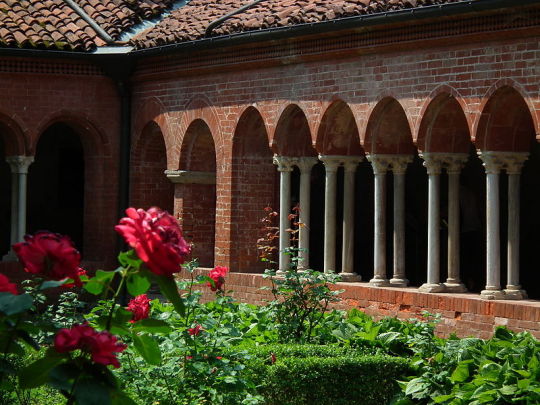
Abbazia di Santa Maria di Staffarda - Chiostro
Staffarda Abbey (Abbazia Santa Maria di Staffarda) is a Cistercian monastery located near Saluzzo in north-west Italy; it was founded as a daughter house of Tiglieto Abbey in 1135 by Manfred I, Marquis of Saluzzo. The abbey became an important local centre for agriculture and held a flourishing market. It was placed in commendam to the Order of Saints Maurice and Lazarus in 1750.
A portrait of Cesare Alessandro Scaglia di Verrua, abbot of Staffarda, painted by Antony van Dyck in about 1634, is now in the National Gallery in London.
An important musical manuscript, the Codex Staffarda, dating to the 1480s or 1490s and containing reference to the commandatory abbot Brixianus Taparelli, is now in the National University Library of Turin. It includes polyphonic works by Renaissance composers such as Jacob Obrecht and Antoine Brumel, as well as the earliest surviving example of a polyphonic Dies Irae by an otherwise unknown composer, Engarandus Juvenis.
#Abbazia Santa Maria di Staffarda#Staffarda Abbey#Saluzzo#Piemonte#Piedmont#Italia#Italy#Abbey#monastery#photo#photography#Architecture#interior#chiostro#cloister#photoset
7 notes
·
View notes
Photo






Favorite History Books || Fulk Nerra, the Neo-Roman Consul 987-1040: A Political Biography of the Angevin Count by Bernard Bachrach ★★★★☆
Conspicuous by their absence from the twelfth-century appreciations of Fulk’s persona are two very personal characteristics: his immense or ferocious temper and his abiding fear of hell. These traits are well attested in the Angevin count’s own documents as well as in those of his contemporaries. We cannot doubt that the writers at the Angevin court were aware of these aspects of Fulk’s personality, and their concern for his bad temper is manifest in the way they edited Sallust’s description of Caesar. Just as they omitted “exercitus” from the list of Fulk’s desiderata because it would obviously have struck a false note, they excised “facilitas” (easygoing, or even-tempered) from the description of his personality, even though Sallust had made a point of ascribing this characteristic to Caesar.
Fulk Nerra, unlike a Roman aristocrat, was not embarrassed to have deeply emotional aspects of his personality publicly bruited about; rather he took advantage of them. Fulk’s temper reached almost legendary proportions during his own lifetime. Thus, for example, Abbot Adhebertus and the monks of Saint-Florent testified that they agreed to the Angevin count’s demands because “of his overwhelming ferocity.” The tradition at Saint-Florent recorded in its History also emphasized Fulk’s ferocity and cunning; the author compared both Fulk and his son to wild beasts.
Fulk’s reputation for ferocity no doubt played a significant role in cowing potentially uncooperative clerics. But this reputation for ferocity combined with his widely recognized strenuitas resulted in his being considered elegantissimus bellicus rebus. Fulk’s adroitness in military activities is noted to have encouraged enemy garrisons to surrender sub lege deditionis, before actual fighting was begun, so that the wrath of the victor might be circumscribed by legal limitation. Thus, the historians at the Angevin court could observe in good faith that Fulk, like Caesar, came to be known for pardoning those he conquered. Fulk also felt it desirable to publish his deep fear of Gehenna and his anxiety that “the last moment of life may come to an end in a very sudden manner.” Indeed, Fulk ascribed to a presentation of the latter idea in a style that was much beholden to Seneca. Fulk dealt with his deep feeling in an unusual manner: his four pilgrimages to the Holy Land. Yet the Angevin count clearly did not have the type of “religious” personality exhibited by rulers like Louis the Pious, whose excesses made him a hostage to the bishops, nor did he have the “irresponsible” personality of Robert of Normandy, who left a child as heir to his unsettled duchy.
Fulk’s first pilgrimage to atone for the great slaughter of Christians at the battle of Conquereuil in 992 was undertaken in 1003, more than a decade after his “sins” had been committed. Fulk left for the Holy Land only after the political situation in Anjou had been stabilized and the succession of an adult male, his half-brother Maurice, had been arranged. Fulk’s second pilgrimage in fact commenced shortly after the murder of Hugh of Beauvais in 1009, but this journey was not primarily an act of atonement but a stroke of naked Realpolitik designed to avoid the consequences of the murder he had ordered. In the same vein as his first pilgrimage, the journey in 1035 had the primary aim of atoning for a massive slaughter of Christians, this time at Pontlevoy. This battle, however, was fought in 1016, almost two decades earlier. Fulk’s final pilgrimage, as he was nearing three score and ten, may have been one of atonement for orchestrating the murder of Robert of Normandy and/or that of Alan of Rennes. It is also likely that this last journey was Fulk’s way of gracefully retiring and leaving the reins of the Angevin government in the capable hands of Geoffrey Martel.
#litedit#historyedit#fulk nerra#french history#medieval#european history#history#history books#nanshe's graphics#i originally read this to write hp fanfic#look i'm very dedicated in my research ok
16 notes
·
View notes
Photo

Portrait of abbot, Maurice Quentin de La Tour
27 notes
·
View notes
Photo

Design for a Wall Tomb with Saint Bernardino and Saint Anthony Abbot, Alessandro Casolani, 16th century, Harvard Art Museums: Drawings
Harvard Art Museums/Fogg Museum, Purchase through the generosity of an anonymous donor and the Kate, Maurice R. and Melvin R. Seiden Fund in honor of F. Gordon and Elizabeth Morrill Size: 28.8 x 19.7 cm (11 5/16 x 7 3/4 in.) Medium: Black chalk on cream antique laid paper
https://www.harvardartmuseums.org/collections/object/312277
3 notes
·
View notes
Text
2nd January 1264: Marriage and Murder in Mediaeval Menteith

(Priory of Inchmahome, founded on one of the islands of Lake of Menteith in the thirteenth century)
On 2nd January 1264, Pope Urban IV despatched a letter to the bishops of St Andrews and Aberdeen, and the Abbot of Dunfermline, commanding them to enquire into a succession dispute in the earldom of Menteith. Situated in the heart of Scotland, this earldom stretched from the graceful mountains and glens of the Trossachs, to the boggy carseland west of Stirling and the low-lying Vale of Menteith between Callander and Dunblane. The earls and countesses of Menteith were members of the highest rank of the nobility, ruling the area from strongholds such as Doune Castle, Inch Talla, and Kilbryde. Perhaps the best-known relic of the mediaeval earldom is the beautiful, ruined Priory of Inchmahome, which was established on an island in Lake of Menteith by Earl Walter Comyn in 1238. Walter Comyn was a powerful, if controversial, figure during the reigns of Kings Alexander II and Alexander III. He controlled the earldom for several decades after his marriage to its Countess, Isabella of Menteith, but following Walter’s death in 1258 his widow was beset on all sides by powerful enemies. These enemies even went so far as to capture Isabella and accuse her of poisoning her husband. The story of this unfortunate countess offers a rare glimpse into the position of great heiresses in High Mediaeval Scotland, revealing the darker side of thirteenth century politics.
Alexander II and Alexander III are generally remembered as powerful monarchs who oversaw the expansion and consolidation of the Scottish realm. During their reigns, dynastic rivals like the MacWilliams were crushed, regions such as Galloway and the Western Isles formally acknowledged Scottish overlordship, and the Scottish Crown held its own in diplomacy and disputes with neighbouring rulers in Norway and England. Both kings furthered their aims by promoting powerful nobles in strategic areas, but it was also vital to harness the ambition and aggression of these men productively. In the absence of an adult monarch, unchecked magnate rivalry risked destabilising the realm, as in the years between 1249 and 1262, when Alexander III was underage.

(A fifteenth century depiction of the coronation of Alexander III. Source: Wikimedia Commons)
Walter Comyn offers a typical picture of the ambitious Scottish magnate. Ultimately loyal to the Crown, his family loyalties and personal aims nonetheless made him a divisive figure. A member of the powerful Comyn kindred, he had received the lordship of Badenoch in the Central Highlands by 1229, probably because of his family’s opposition to the MacWilliams. In early 1231, he was granted the hand of a rich heiress, Isabella of Menteith. In the end, there would be no Comyn dynasty in Menteith: Walter and Isabella had a son named Henry, mentioned in a charter c.1250, but he likely predeceased his father. Nevertheless, Walter Comyn carved out a career at the centre of Scottish politics and besides witnessing many royal charters, he acted as the king’s lieutenant in Galloway in 1235 and became embroiled in the scandalous Bisset affair of 1242.
When Alexander II died in 1249, Walter and the other Comyns sought power during the minority of the boy king Alexander III. They were opposed by the similarly ambitious Alan Durward and in time Henry III of England, the attentive father of Alexander III’s wife Margaret, was also dragged into the squabble as both sides solicited his support in order to undermine their opponents. Possession of the young king’s person offered a swift route to power, and, although nobody challenged Alexander III’s right to the throne, some took drastic measures to seize control of government. Walter Comyn and his allies managed this twice, the second time by kidnapping the young king at Kinross in 1257. They were later forced to make concessions to enemies like Durward but, with Henry III increasingly distracted by the deteriorating political situation in England, the Comyns held onto power for the rest of the minority. However Walter only enjoyed his victory for a short while: by the end of 1258, the Earl of Menteith was dead.
Walter Comyn had dominated Scottish politics for a decade, and even if, as Michael Brown suggests, his death gave the political community some breathing space, this also left Menteith without a lord. As a widow, Countess Isabella theoretically gained more personal freedom, but mediaeval realpolitik was not always consistent with legal ideals. In thirteenth century Scotland, the increased wealth of widows made them vulnerable in new ways (not least to abduction) and, although primogeniture and the indivisibility of earldoms were promoted, in reality these ideals were often subordinated to the Crown’s need to reward its supporters. Isabella of Menteith was soon to find that her position had become very precarious.

At first, things went well. Although one source claims that many noblemen sought her hand, Isabella made her own choice, marrying an English knight named John Russell. Sir John’s background is obscure but, despite assertions that he was low born, he had connections at the English court. Isabella and John obtained royal consent for their marriage c.1260, and the happy couple also took crusading vows soon afterwards.
But whatever his wife thought, in the eyes of the Scottish nobility John Russell cut a much less impressive figure than Walter Comyn. The couple had not been married long before a powerful coterie of nobles descended on Menteith like hoodie-crows. Pope Urban’s list of persecutors includes the earls of Buchan, Fife, Mar, and Strathearn, Alan Durward, Hugh of Abernethy, Reginald le Cheyne, Hugh de Berkeley, David de Graham, and many others. But the ringleader was John ‘the Red’ Comyn, the nephew of Isabella of Menteith’s deceased husband Walter, who had already succeeded to the lordship of Badenoch. Even though Menteith belonged to Isabella in her own right, Comyn coveted his late uncle’s title there. Supported by the other lords, he captured and imprisoned the countess and John Russell, and justified this bold assault by claiming that the newlyweds had conspired together to poison Earl Walter. It is unclear what proof, if any, John Comyn supplied to back up his claim, but the couple were unable to disprove it. They were forced to surrender all claims to Isabella’s dowry, as well as many of her own lands and rents. A surviving charter shows that Hugh de Abernethy was granted property around Aberfoyle about 1260, but it seems that the lion’s share of the spoils went to the Red Comyn, who secured for himself and his heirs the promise of the earldom of Menteith itself.
Isabella and her husband were only released when they promised to pass into exile until they could clear their names before seven peers of the realm. John Russell’s brother Robert was delivered to Comyn as security for their full resignation of the earldom. Having ‘incurred heavy losses and expenses’, which certainly stymied their crusading plans, they fled.

In a letter of 1264, Pope Urban IV described the couple as ‘undefended by the authority of the king, while as yet a minor’. However, though Alexander III was technically underage in 1260, he was now nineteen and could not be ignored entirely. Michael Brown suggests that Isabella and her husband may have been seized when the king was visiting England, and that John Comyn’s unsanctioned bid for the earldom of Menteith may explain why Alexander cut short his stay in November 1260 and hastily returned north, leaving his pregnant queen with her parents at Windsor. Certainly, Comyn was forced to relinquish the earldom before 17th April 1261. But instead of restoring Menteith to its exiled countess, Alexander settled the earldom on another rising star: Walter ‘Bailloch’ Stewart, whose wife Mary had a claim to Menteith.
Mary of Menteith is often described as Isabella’s younger sister, although contemporary sources never say so and some historians argue that they were cousins. Either way, Alexander’s decision to uphold her claim was probably as much influenced by her husband’s identity as her alleged birth right. Like Walter Comyn, Walter Bailloch (‘freckled’), belonged to an influential family as the brother of Alexander, Steward of Scotland. From their origins in the royal household, the Stewarts became major regional magnates, assisting royal expansion in the west. The promising son of a powerful family, Walter Bailloch was sheriff of Ayr by 1264 and likely fought in the Battle of Largs in 1263. In 1260 Alexander III had the opportunity to secure Walter’s loyalty as the royal minority drew to a close. Conversely John Comyn of Badenoch found himself out of favour and was removed as justiciar of Galloway following the Menteith incident. The king would not alienate the Comyns permanently, but for now, the stars of Walter Bailloch and Mary of Menteith were in the ascendant.

(Loch Lubnaig, in the Trossachs, another former possession of the earls of Menteith)
Isabella of Menteith and John Russell had not been idle in the meantime. Travelling to John’s home country of England, they probably appealed to Henry III. In September 1261, the English king inspected documents relating to a previous dispute over the earldom of Menteith. On that occasion, two brothers, both named Maurice, had their differences settled before the future Alexander II at Edinburgh in 1213. The elder Maurice, who held the title Earl of Menteith and was presumed illegitimate by later writers (though this is never stated), resigned the earldom, which was regranted to Maurice junior. In return the elder Maurice received some towns and lands to be held for his lifetime only, and the younger Maurice promised to provide for the marriage of his older brother’s daughters.
It is probable that Isabella was the daughter of the younger Maurice, and that she produced these charters as proof of her right to the earldom. Perhaps Mary was her younger sister, but it seems likelier that Isabella would have wanted to prove the younger Maurice’s right if Mary was a descendant of the elder brother, and therefore her cousin. However despite Henry III’s formal recognition of the settlement, he did not provide Isabella with any real assistance: for whatever reason, the English king was either unable or unwilling to press his son-in-law the King of Scots on this matter. Isabella then turned instead to the spiritual leader of western Europe- Pope Urban IV.

(A depiction of the coronation of Henry III of England, though in fact the English king was only a child when he was crowned. Source: Wikimedia Commons)
A long epistle which the pope sent to several Scottish prelates in January 1264 has survived, revealing much about the case. Thus we learn that Urban was initially moved by Isabella and her husband’s predicament, perhaps especially so since they had taken the cross. Accordingly, he had appointed his chaplain Pontius Nicholas to enquire further and discreetly arrange the couple’s restoration. Pontius was to journey to Menteith, ‘if he could safely do so, otherwise to pass personally to parts adjacent to the said kingdom, and to summon those who should be summoned’. But Pontius’ mission only hindered Isabella’s suit. According to Gesta Annalia I, the papal chaplain got no closer to Scotland than York. From there he summoned many Scottish churchmen and nobles to appear before him, and even the King of Scots himself. This merely antagonised Alexander III and his subjects. Although Alexander maintained good relations with England and the papacy throughout his reign, he had a strong sense of his own prerogative and did not appreciate being summoned to answer for his actions, especially not outwith his realm and least of all in York. Special daughter of the papacy or not, Scotland’s clergy and nobility supported their king and refused to compear. Faced with this intransigence, Pontius Nicholas placed the entire kingdom under interdict, at which point Alexander retaliated by writing directly to the chaplain’s boss, demanding Pontius’ dismissal from the case.
Urban IV swiftly backpedalled. In a conciliatory tone he claimed that Pontius was guilty of ‘exceeding the terms of our mandate’ and causing ‘grievous scandal’. To remedy the situation, and avoid endangering souls, the pope discharged his responsibility over the case to the bishops of St Andrews and Aberdeen, and the Abbot of Dunfermline. Thus the pope washed his hands of a troublesome case, the Scottish king’s nose could be put back in joint, and Isabella’s suit was transferred to men with great experience of Scottish affairs, who should have been capable of satisfactorily resolving the matter. However, there is no indication that Isabella was ever compensated for the loss of her inheritance, and when the dispute over Menteith was raised again ten years later, the countess was not even mentioned (probably she had since died). Possibly her suit was discreetly buried after it was transferred to the Scottish clerics, a solution which, however frustrating for the exiled countess, would have been convenient for the great men whose responsibility it was to ensure justice was done.

(Doune Castle- the earliest parts of this famous stronghold probably date to the days of the thirteenth century earls of Menteith, although much of the work visible today dates from the late fourteenth and early fifteenth centuries)
The Comyns could not be dismissed so easily. Never resigned to losing Menteith, John Comyn of Badenoch claimed the earldom again c.1273, on behalf of his son William Comyn of Kirkintilloch. William had since married Isabella Russell, daughter of Isabella of Menteith by her second husband.* The 1273 suit was unsuccessful but William Comyn and Isabella Russell did not lose hope, and in 1282, William asked Edward I of England to intercede for them with the king of Scots. In 1285, with William’s father John Comyn long dead, Alexander III finally offered a compromise. Walter Bailloch, whose wife Mary may have died, was to keep half the earldom and he and his heirs would bear the title earl of Menteith. William Comyn and Isabella Russell received the other half in free barony, and this eventually passed to the offspring of Isabella’s second marriage to Sir Edward Hastings. Perhaps this could be seen as a posthumous victory for Isabella Russell’s late parents, but their descendants would never regain the whole earldom (except, controversially, when the younger Isabella’s two sons were each granted half after Edward I forfeited the current earl for supporting Robert Bruce).
Conversely, Walter Bailloch’s descendants remained at the forefront of Scottish politics. He and his wife Mary accompanied Alexander III’s daughter to Norway in 1281, and Walter was later a signatory to both the Turnberry Band and the Maid of Norway’s marriage negotiations. He also acted as a commissioner for Robert Bruce (grandfather to the future king) during the Great Cause. He had at least three children by Mary of Menteith and their sons took the surname Menteith rather than Stewart. The descendants of the eldest son, Alexander, held the earldom of Menteith until at least 1425. The younger son, John, became infamous as the much-maligned ‘Fause Menteith’ who betrayed William Wallace, although he later rose high in the service of King Robert I. Walter Bailloch himself died c.1294-5, and was buried next to his wife at the Priory of Inchmahome on Lake of Menteith, which Walter Comyn had founded over fifty years previously. The effigies of Walter Bailloch and Mary of Menteith can still be seen in the chapter house of the ruined priory: the worn faces are turned towards each other and each figure stretches out an arm to embrace their spouse in a lasting symbol of marital affection.
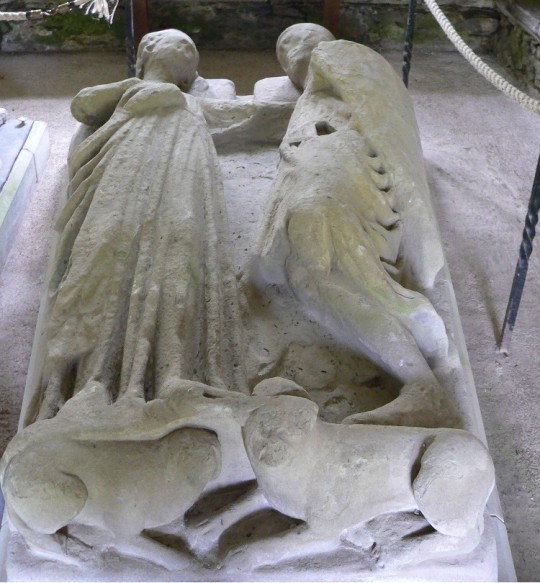
(The effigies of Walter Bailloch and Mary of Menteith at Inchmahome Priory, which was founded by Walter Comyn in 1238 and was perhaps intended as a burial site for himself and his wife Isabella of Menteith. Source: Wikimedia Commons).
The dispute over Menteith saw a prominent noblewoman publicly accused of murder and exiled, and even sparked an international incident when Scotland was placed under interdict. For all this, neither Isabella of Menteith nor John Comyn of Badenoch triumphed in the long term. Even Walter Bailloch eventually had to accept the loss of half the earldom after holding it for over twenty years. In the end the only real winner seems to have been the king. Although at first sight the persecution of Isabella and her husband looks like a classic example of overmighty magnates taking advantage of a breakdown in law and order during a royal minority, Alexander III was not a child and his rebuke of John Comyn did not result in any backlash against the Crown. Most of the Scottish nobility fell back in line once the king came of age, but the king in turn had to ensure that he was able to reward key supporters if he wanted to expand the realm he had inherited. Although it was important to both Alexander III and his father that primogeniture and were accepted by their subjects as the norm, in practice both kings found that they had to bend their own rules to ensure that the system worked to their own advantage. The thirteenth century is often seen an age of legal development and state-building, but these things sometimes came into conflict with each other, and even the most successful kings had to work within a messy system and consider the competing loyalties and customs of their subjects.
Selected Bibliography:
- “Vetera Monumenta Hibernorum et Scotorum”, Augustinus Theiner (a printed version of Urban IV’s original Latin epistle may be found here)
- “John of Fordun’s Chronicle of the Scottish Nation”, vol. 2, ed. W.F. Skene (this is an English translation of the chronicle of John of Fordun, made when Gesta Annalia I was still believed to be his work. It provides an independent thirteenth or fourteenth century Scottish account of the Menteith case
- “The Red Book of Menteith”, volumes 1+2, ed. Sir William Fraser
- “Calendar of Documents Relating to Scotland, Preserved Among the Public Records of England”, volumes 1, 2, 3 & 5, ed. Joseph Bain
- “The Political Role of Walter Comyn, earl of Menteith, during the Minority of Alexander III of Scotland”, A. Young, in the Scottish Historical Review, vol.57 no.164 part 2 (1978).
- “Scotland, England and France After the Loss of Normandy, 1204-1296″, M.A. Pollock
- “The Wars of Scotland, 1214-1371″, Michael Brown
As ever if anyone has a question about a specific detail or source, please let me know! I have a lot of notes for this post, so hopefully I should be able to help!
#Scottish history#Scotland#British history#thirteenth century#women in history#Menteith#earldom of Menteith#Isabella Countess of Menteith#John Russell#John Comyn I of Badenoch#Alexander III#Henry III#Pope Urban IV#Walter Bailloch#the Stewarts#House of Dunkeld#House of Canmore#Mary of Menteith#inchmahome priory
13 notes
·
View notes
Text
#5 The climax : Sous le soleil de Satan

There is a film that stands out from the rest of Maurice Pialat's filmography and that veers towards theatrical phrasing with a touch of fantasy.
Released in 1987, Sous le soleil de Satan is adapted from the novel of the same name by Georges Bernanos and tells the story of the strange relationship between an abbot, played by Gérard Depardieu, and a 16-year-old girl, interpreted by Sandrine Bonnaire, who has killed her lover. By its atmosphere, its message and its dialogues, the film is by far the most inaccessible of the filmography of Maurice Pialat. Sous le soleil de Satan is a hard and bewitching film that brings to the audience very different feelings, which was well demonstrated by the viewers at the Cannes Film Festival. Indeed, in 1987, Pialat received the Palme d'Or for this film. When he went on stage to collect the prize, he was booed and hissed by an audience that disagreed with the choice of the jury, chaired this year by Yves Montand, which had nevertheless decided unanimously to reward the film of the French director. True to his reputation, Pialat did not let it happen. On stage, he raises his fist and says "If you don't like me, I can tell you that I don't like you either! "
1 note
·
View note